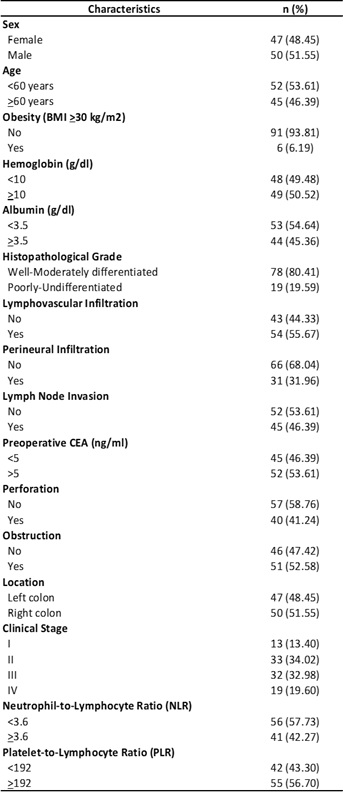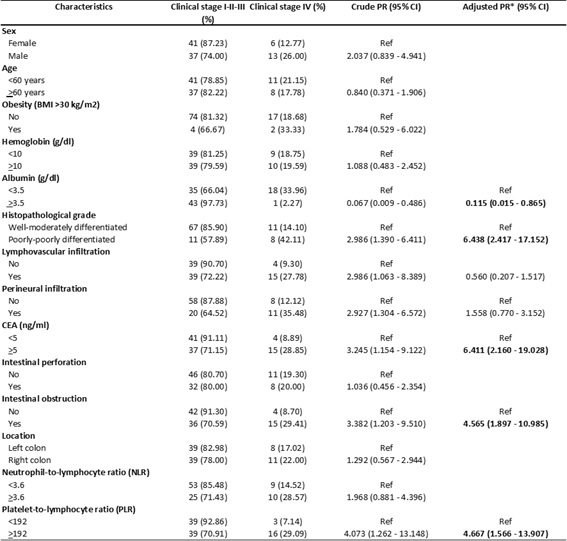Monday Poster Session
Category: Colon
P2461 - Clinical and Pathological Factors Associated With Advanced Stage Colorectal Cancer: A Cross-Sectional Study in Peru
Monday, October 27, 2025
10:30 AM - 4:00 PM PDT
Location: Exhibit Hall
- AF
Andre J. Fuentes Yufra, MD (he/him/his)
Universidad Privada de Tacna
Tacna, Tacna, Peru
Presenting Author(s)
Claudia P.. Pinto Narvaez, MD1, Andre J.. Fuentes Yufra, MD2, Allison N.. Ortiz Pardo, MD3, Jose M.. Vela Ruiz, MD4
1Universidad Ricardo Palma, Lima, Lima, Peru; 2Universidad Privada de Tacna, Tacna, Tacna, Peru; 3Peruvian American Medical Society, Lima, Lima, Peru; 4Universidad Ricardo Palma, Lima, Lima, Lima, Peru
Introduction: Colorectal cancer (CRC) is one of the most common and deadly neoplasms worldwide. According to GLOBOCAN 2022, there were over one million new cases globally, including 96,025 new cases and 53,585 deaths in Latin America. By 2040, the CRC burden is expected to increase by 63%.
Approximately 1 in 5 patients present with metastasis at the time of diagnosis, increasing morbidity, mortality, and the economic burden on healthcare systems and families. This study aimed to identify clinicopathological factors associated with advanced-stage CRC, which could contribute to improving preventive and follow-up strategies.
Methods: We conducted an observational, analytical, cross-sectional study including patients over 18 years old diagnosed with CRC at María Auxiliadora Hospital (Lima, Peru) between 2016 and 2020. The statistical power was 99.99%, based on the study by Mermut et al. Patients with autoimmune or infectious diseases were excluded.
The dependent variable was stage IV CRC, confirmed by multidetector computed tomography (MDCT). Independent variables were selected based on a literature review. For multivariate analysis, Poisson regression with robust variance was used. Variables with p< 0.05 in the crude analysis were included in the adjusted model.
Results: Of 116 CRC patients, 19 were excluded due to incomplete medical records. Nearly 20% were diagnosed at stage IV. Elevated platelet-to-lymphocyte ratio (PLR >192) was observed in 56.7%, and 44.3% had serum albumin < 3.5 g/dL. Lymphovascular invasion was present in 55.7%, and perineural invasion in 32%. Poorly differentiated carcinoma was found in 19.6%, and carcinoembryonic antigen (CEA) >5 ng/mL in 53.6%.
In the adjusted model, PLR >192 (aPR: 4.67; 95% CI: 1.57–13.91), poorly differentiated CRC (aPR: 6.44; 95% CI: 2.42–17.15), CEA >5 ng/mL (aPR: 6.41; 95% CI: 2.16–19.03), and intestinal obstruction (aPR: 4.56; 95% CI: 1.90–10.98) were associated with an increased prevalence of stage IV CRC, while serum albumin >3.5 g/dL was a protective factor (aPR: 0.12; 95% CI: 0.02–0.87).
Discussion: Elevated PLR, poor histologic grade, high CEA levels, and intestinal obstruction were associated with stage IV CRC, whereas serum albumin >3.5 g/dL acted as a protective factor. Greater emphasis should be placed on evaluating complete blood count and albumin levels, as these are low-cost, accessible tools that can be implemented in primary care for CRC follow-up.

Figure: Table 1: Clinical andlLaboratory characteristics of patients with Colorectal Cancer attended at María Auxiliadora Hospital (Lima, Peru) during 2016-2020

Figure: Table 2: Clinical and pathological factors associated with stage IV Colorectal Cancer patients at María Auxiliadora Hospital (Lima, Peru) during 2016-2020
*Adjusted for serum albumin level, histopathological grade, lymphovascular invasion, perineural invasion, carcinoembryonic antigen (CEA), intestinal obstruction, and platelet-to-lymphocyte ratio (PLR)
Disclosures:
Claudia Pinto Narvaez indicated no relevant financial relationships.
Andre Fuentes Yufra indicated no relevant financial relationships.
Allison Ortiz Pardo indicated no relevant financial relationships.
Jose Vela Ruiz indicated no relevant financial relationships.
Claudia P.. Pinto Narvaez, MD1, Andre J.. Fuentes Yufra, MD2, Allison N.. Ortiz Pardo, MD3, Jose M.. Vela Ruiz, MD4. P2461 - Clinical and Pathological Factors Associated With Advanced Stage Colorectal Cancer: A Cross-Sectional Study in Peru, ACG 2025 Annual Scientific Meeting Abstracts. Phoenix, AZ: American College of Gastroenterology.
1Universidad Ricardo Palma, Lima, Lima, Peru; 2Universidad Privada de Tacna, Tacna, Tacna, Peru; 3Peruvian American Medical Society, Lima, Lima, Peru; 4Universidad Ricardo Palma, Lima, Lima, Lima, Peru
Introduction: Colorectal cancer (CRC) is one of the most common and deadly neoplasms worldwide. According to GLOBOCAN 2022, there were over one million new cases globally, including 96,025 new cases and 53,585 deaths in Latin America. By 2040, the CRC burden is expected to increase by 63%.
Approximately 1 in 5 patients present with metastasis at the time of diagnosis, increasing morbidity, mortality, and the economic burden on healthcare systems and families. This study aimed to identify clinicopathological factors associated with advanced-stage CRC, which could contribute to improving preventive and follow-up strategies.
Methods: We conducted an observational, analytical, cross-sectional study including patients over 18 years old diagnosed with CRC at María Auxiliadora Hospital (Lima, Peru) between 2016 and 2020. The statistical power was 99.99%, based on the study by Mermut et al. Patients with autoimmune or infectious diseases were excluded.
The dependent variable was stage IV CRC, confirmed by multidetector computed tomography (MDCT). Independent variables were selected based on a literature review. For multivariate analysis, Poisson regression with robust variance was used. Variables with p< 0.05 in the crude analysis were included in the adjusted model.
Results: Of 116 CRC patients, 19 were excluded due to incomplete medical records. Nearly 20% were diagnosed at stage IV. Elevated platelet-to-lymphocyte ratio (PLR >192) was observed in 56.7%, and 44.3% had serum albumin < 3.5 g/dL. Lymphovascular invasion was present in 55.7%, and perineural invasion in 32%. Poorly differentiated carcinoma was found in 19.6%, and carcinoembryonic antigen (CEA) >5 ng/mL in 53.6%.
In the adjusted model, PLR >192 (aPR: 4.67; 95% CI: 1.57–13.91), poorly differentiated CRC (aPR: 6.44; 95% CI: 2.42–17.15), CEA >5 ng/mL (aPR: 6.41; 95% CI: 2.16–19.03), and intestinal obstruction (aPR: 4.56; 95% CI: 1.90–10.98) were associated with an increased prevalence of stage IV CRC, while serum albumin >3.5 g/dL was a protective factor (aPR: 0.12; 95% CI: 0.02–0.87).
Discussion: Elevated PLR, poor histologic grade, high CEA levels, and intestinal obstruction were associated with stage IV CRC, whereas serum albumin >3.5 g/dL acted as a protective factor. Greater emphasis should be placed on evaluating complete blood count and albumin levels, as these are low-cost, accessible tools that can be implemented in primary care for CRC follow-up.

Figure: Table 1: Clinical andlLaboratory characteristics of patients with Colorectal Cancer attended at María Auxiliadora Hospital (Lima, Peru) during 2016-2020

Figure: Table 2: Clinical and pathological factors associated with stage IV Colorectal Cancer patients at María Auxiliadora Hospital (Lima, Peru) during 2016-2020
*Adjusted for serum albumin level, histopathological grade, lymphovascular invasion, perineural invasion, carcinoembryonic antigen (CEA), intestinal obstruction, and platelet-to-lymphocyte ratio (PLR)
Disclosures:
Claudia Pinto Narvaez indicated no relevant financial relationships.
Andre Fuentes Yufra indicated no relevant financial relationships.
Allison Ortiz Pardo indicated no relevant financial relationships.
Jose Vela Ruiz indicated no relevant financial relationships.
Claudia P.. Pinto Narvaez, MD1, Andre J.. Fuentes Yufra, MD2, Allison N.. Ortiz Pardo, MD3, Jose M.. Vela Ruiz, MD4. P2461 - Clinical and Pathological Factors Associated With Advanced Stage Colorectal Cancer: A Cross-Sectional Study in Peru, ACG 2025 Annual Scientific Meeting Abstracts. Phoenix, AZ: American College of Gastroenterology.
